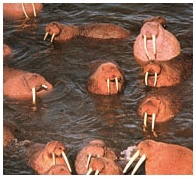
 The In (the Water) Crowd Walruses like the company of other walruses. They are very social animals and gather by the hundreds. They like to do everything in herds and seldom go out alone. The herds and subgroups have clearly defined social structures, and levels of dominance are well established. Ranking is established by tusk size, body size, and aggressiveness. The largest walruses with the longest tusks are usually the most aggressive and threatening, and they bully their way to the best sites. The poor little guys with small or broken tusks have a lower social standing and have to settle for what's left. Males and females form separate herds, but when males go looking for girlfriends, they get noisy (vocalizations are an important part of the courtship display) and jealous - they'll fight other males who intrude, and when they start waving those tusks around, somebody usually gets hurt. They sound a bit like people, don't they?
Click pictures for more information and credits. Library: Walruses, Arctic, Animals Links: Arctic, Arctic Animals Arctic Maps & Weather Reports |

|
DICTIONARY: Just "double-click" any unlinked word on this page for the definition from Merriam-Webster's Student Electronic Dictionary at Word Central. |

|
ARCTIC LIBRARY & GLOSSARY: Check this section for an index of the rest of the things you really need to know about the Arctic. |

|
ARCTIC MAPS & WEATHER REPORTS: Maps of the Northwest Passage, explorers' routes, iceberg sources, Nunavut, the Arctic by treeline, temperature... |

|
ARCTIC LINKS: Even more information! Links to sites related to the Arctic and "Iceberg: the Story of the Throps and the Squallhoots". |

|
GUIDE TO ARCTIC SUNRISE & SUNSET: How much sunlight or darkness is there in the Arctic on each day of the year? |
to is the property of their respective owners, and Athropolis is not responsible for their content.